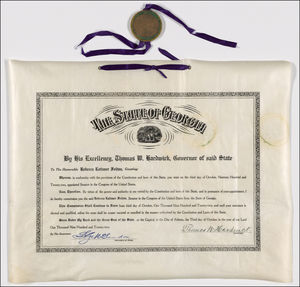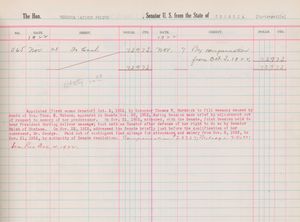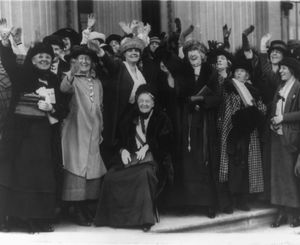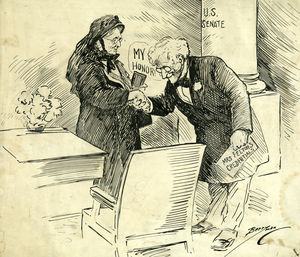On November 21, 1922, Rebecca Felton of Georgia took the oath of office, becoming the first woman to serve in the U.S. Senate. Though her legacy has been tarnished by her racism, the significance of this milestone—now 100 years old—remains. Felton’s historic appointment opened the door for other women senators to follow. One hundred years later, 59 women have been elected or appointed to the Senate, and many more women have supported Senate operations as elected officers and staff.

Appointed to fill a vacant seat on October 3, 1922, Felton formally took the oath of office in the Senate Chamber on November 21 and served only 24 hours while the Senate was in session. For Felton, that historic day marked the culmination of a lifetime of political activism as a feminist, journalist, and suffragist. Like many of her contemporaries, however, Felton was also a white supremacist whose views on race both reflected and reinforced racial inequality for generations. Her complicated legacy sheds light on both the progressive and the reactionary politics that she influenced in the late 19th and early 20th centuries.
Born Rebecca Latimer in 1835, she was the daughter of a wealthy Georgia planter. She married Dr. William Felton in 1853, moving to his home near Cartersville. Although the state of Georgia prohibited women from owning property at that time, as the mistress of her husband’s plantation, Felton managed a household that included 50 enslaved people.
In 1860, as Civil War approached, the Feltons initially opposed the secession of Southern states from the Union, but like other white Southerners of their social class, they supported the Confederacy during the war to protect their “ownership of African slaves.” Felton later explained, “All I owned was invested in slaves.” She joined the local Ladies Aid Society to support the Confederate army. A physician and a preacher, William Felton tended Confederate soldiers at a nearby military camp, frequently leaving Rebecca alone to defend their property. Physical assault by marauding soldiers was a common wartime experience for rural women like Felton, and their trauma informed Felton’s political advocacy as she later fought for financial security and protection from sexual violence for all women.1
When the war concluded, the Feltons were emotionally depressed and financially destitute. They lost their farm and livelihood during the war and suffered the loss of two young children to wartime diseases. They founded a school, but politics soon came calling. After a report of the brutal sexual assault of a Black girl in a chain gang, Rebecca petitioned the Georgia state legislature to enhance protections for all female labor convicts—Black and white—and she would fight for prison reform for the remainder of her life. William pursued electoral politics, serving in the U.S. House of Representatives and the Georgia state legislature. Felton participated in all aspects of her husband’s career, serving as his campaign manager and speechwriter, atypical roles for a woman in the 19th century. Political opponents criticized their unusual partnership. “We sincerely trust that the example set by Mrs. Felton will not be followed by southern ladies,” complained the Thomasville Times. “Let the dirty work in politics be confined to men.” By serving as her husband’s partner, and at times as his political surrogate, Felton helped to redefine the “traditional” role of southern white women.2
In the 1880s, Rebecca Felton broadened her activism, joining the temperance movement and emerging as a prominent and dynamic public speaker for the rights of poor, rural white women. A prolific and engaging writer, she co-founded a small newspaper in 1885 and later wrote a semi-weekly column for the Atlanta Journal. By the 1890s, Felton had emerged as a prominent public figure whose rousing speeches drew large crowds and whose columns and letters to the editor were widely distributed and debated nationwide. Felton used her influence to push for progressive policy reforms on behalf of white women and children, including universal public education, prison reform, better employment opportunities for women, and female suffrage.3
Felton’s views on race, however, were far from progressive, and throughout her life she held and perpetuated racist attitudes about African Americans. Decades after the Civil War, she continued to promote the myth of the happy enslaved person. She dehumanized Black men, calling them “debased, lustful brutes.” In her memoirs, published in 1919, Felton acknowledged that white supremacy served as an organizing principle for white southerners during and after the war. “The dread of negro insurrection and social equality with negroes at the ballot box held the Southern whites together in war or peace.” By the 1890s, many former Confederate states had adopted new constitutions to restrict African Americans’ civil rights, particularly voting rights. Prominent political figures, including Felton, inflamed racial tensions by promoting unfounded allegations of Black men assaulting white women. Such allegations fueled the heinous practice of lynching.4
In a widely reported speech in 1897, Felton criticized white men for their indifference to women’s rights and their failure to protect white women from assault, promoting her vision of equality for farm women. In the final moments of the speech, however, she pivoted to reactionary race politics: “As long as your politicians take the colored man into their embrace on election day…so long will lynching prevail.…If it needs lynching to protect woman’s dearest possession from the ravening human beasts,” she said, “then I say lynch, a thousand times a week if necessary.” Although the purpose of her speech had been to promote the empowerment of white rural women, in the weeks and months that followed, it was Felton’s virulent support for lynching that was widely reported and used as justification for this barbaric practice.5
Shortly after her husband’s death in 1909, Felton joined the suffrage movement and canvassed the state to promote voting rights for women. Racism played a prominent role here as well, with many leading white suffragists insisting that extending voting rights to white women would help to dilute the voting power of Black men. When Felton testified before the all-male Georgia state legislature in 1914, for example, she asked: “Why can’t [women] help you make the laws the same as they help you run your homes and churches? I do not want to see a negro man walk to the polls and vote … while I myself [cannot].” In 1920 Felton and fellow suffragists celebrated the ratification of the Nineteenth Amendment, which extended voting rights to many, though not all, women. Her suffrage work enhanced her popularity among newly enfranchised women voters in Georgia and beyond.6

In September 1922, when Georgia senator Thomas Watson died in office, he left a vacancy to be filled by gubernatorial appointment until the upcoming special election. Georgia governor (and former senator) Thomas Hardwick planned to appoint a “place-holder” and then run for that seat himself. Because he had opposed the Nineteenth Amendment, Hardwick feared newly enfranchised women would deny him the coveted Senate seat. On October 3, 1922, hoping to quell their opposition, Hardwick chose 87-year old Rebecca Latimer Felton of Cartersville for the historic appointment.
Hardwick ceremonially presented Felton with her appointment at Bartow County Courthouse on October 6. Women packed the courthouse, eager to show their support for the first woman senator. Because the Senate had adjourned sine die until December, and her replacement would be elected on November 7, Hardwick’s action was viewed as a symbolic attempt to gain women’s votes. Though Felton would receive a Senate salary and the administrative support of a secretary, as one newspaper reported, it was “only remotely possible” that she would appear on the Senate floor.7
Not content with a remote possibility, Felton’s allies launched an effort to have her seated in the Senate. Helen Longstreet, the widow of Georgia’s Confederate general James Longstreet, petitioned President Warren G. Harding in person on October 5, requesting that he call a special session before the November election so that Felton could be sworn in. Others followed Longstreet’s lead. “I voice the desire of multitudes of women voters,” explained one prominent suffragist in a letter to Harding, “who will shortly be approaching the polls.” Harding ignored the political pressure for a time, resisting calls for a special session. Meanwhile, on October 17, Governor Hardwick lost the Democratic primary to Judge Walter George, who won the general election on November 7. Felton now had an elected successor, but that didn’t halt the pressure to provide her the opportunity to take a Senate seat. Felton lobbied Harding to call Congress back for a special session as many of her supporters petitioned the president for action. On November 9, the president relented, announcing a special session to begin November 20 to consider several Republican legislative priorities. Attention again turned to Felton. Would she be seated?8
Less than a week before the special session was scheduled to convene, Georgia secretary of state S. G. McLendon, Felton’s political ally, declared that Walter George’s election likely would not be certified before the special session began. The ballots of 14 Georgia counties remained to be counted, he explained, and the state canvassing board had yet to be called to certify those results. According to state law, only the governor had the authority to convene the canvassing board, and Governor Hardwick was vacationing in New York. To resolve the situation, Hardwick returned to Georgia and convened the board, which promptly certified the election results. When the Senate convened on November 20, Senator-elect Walter George would be certified and ready to present his credentials. To many, Felton’s chances of taking the oath of office in an open session seemed to be dwindling.9
Undeterred, Felton personally asked George to delay presenting his credentials to the Senate. “I have no objections to interpose,” George astutely proclaimed at a press conference after their meeting. “The Senate is the exclusive judge of the eligibility of its members.… I will be glad to see the distinction come to [Felton], if the Senate can and will find a way to make this legally possible.” After George’s public announcement, Felton’s goal seemed within reach. She packed her bags and boarded a train to Washington, D.C. Both she and George would be present when the Senate convened for the special session. The Senate would decide her fate.10

On Monday, November 20, Felton arrived at the Senate early, her credentials tucked under her arm. Escorted into the Chamber by former Georgia senator Hoke Smith, she took a seat at an empty desk. Senators surrounded her, extending her a warm welcome. When the Senate convened at noon, it approved a resolution recognizing the death of her predecessor Thomas Watson and then—as was Senate custom—adjourned for the day. The question of Felton taking the oath would have to wait another 24 hours.
Felton again arrived early on November 21 and received a raucous ovation from visitors in the galleries as she took a seat at Watson’s vacant desk. After recessing for a joint session, the Senate reconvened, accepted the credentials of two new members, and then turned to deciding Felton’s case. Thomas Walsh of Montana addressed the chair. First describing the law that seemed to prevent Felton from being seated, Walsh then provided precedents in her favor. “I did not like to have it appear, if the lady is sworn in—as I have no doubt she is entitled to be sworn in—that the Senate … extend[ed] so grave a right to her as a favor, or as a mere matter of courtesy, or being moved by a spirit of gallantry,” he said, “but rather that the Senate, being fully advised about it, decided that she was entitled to take the oath.” Without objection, the clerk proceeded to read the certificate as presented by Felton, and Vice President Calvin Coolidge administered the oath of office shortly after noon.11
As a duly sworn senator, Felton answered one roll call and delivered a single speech. "When the women of the country come in and sit with you,” she told her Senate colleagues, “...you will get ability, you will get integrity..., you will get exalted patriotism, and you will get unstinted usefulness." She served for 24 hours before relinquishing the seat to Senator-elect Walter George. A gallery full of women erupted into cheers and applause as Senator Felton bade farewell.12

Following her appointment, Felton had predicted that women’s era had dawned, but women’s time in the Senate had begun to dawn even before Felton’s historic appointment. The Senate had already benefitted from a small but talented group of pioneering female staff, including Leona Wells, who joined the Senate's clerical staff in 1901 and became one of the first women to serve as lead clerk on a committee. By the early 1920s, women held half of the Senate’s committee staff positions. Today, women hold many of the most important and influential posts in the Senate, including secretary of the Senate and sergeant at arms.13
As Felton predicted, however, her historic appointment did pave the way for other trailblazing women senators. Hattie Caraway of Arkansas became the first woman to win election to the Senate in 1932 and subsequently the first to chair a committee. In 1938 Senator Gladys Pyle of South Dakota became the first Republican woman to serve in the Senate. Margaret Chase Smith of Maine took the oath of office in 1949, becoming the first woman to serve in both the House of Representatives and the Senate. Carol Moseley Braun of Illinois, having prevailed in the general election of 1992, was the first African American woman senator. In 1995 Barbara Mikulski of Maryland set a milestone by becoming the first woman elected to Democratic Party leadership, and in 2000 Senator Kay Bailey Hutchison of Texas achieved that goal for the Republican Party. Other milestones followed. In 2013 Mazie Hirono of Hawaii became the first Asian and Pacific Islander woman to take the oath, while Tammy Baldwin of Wisconsin became the first openly gay senator. The first Latina, Catherine Cortez Masto, joined the Senate in 2017. When Vice President Kamala Harris took the oath of office in 2021, she became the first woman to serve as president of the Senate and the first Asian American and African American to hold that position. On November 5, 2022, Senator Dianne Feinstein of California became the longest serving woman senator, with more than 30 years of Senate service. To date, 59 women have followed the trail blazed by Felton in 1922, with 24 serving in the 117th Congress. While historians continue to reckon with the troubling aspects of Felton’s life and career, her legacy as the first woman senator remains a significant milestone—now 100 years old—in the history of the Senate.
Notes
13. “Women of the Senate,” United States Senate, accessed November 7, 2022, https://www.senate.gov/about/women-of-the-senate.htm